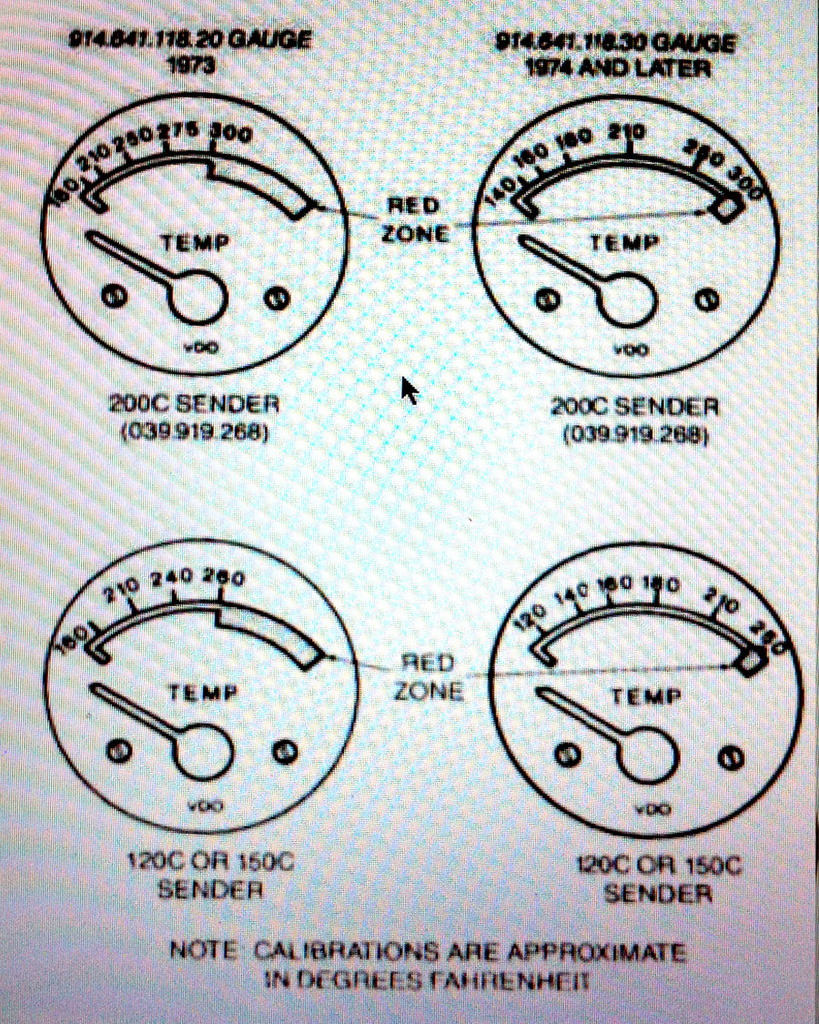Printable Version of Topic
Click here to view this topic in its original format
914World.com _ 914World Garage _ A question about wire sizes
Posted by: ericoneal May 13 2019, 07:29 PM
After some spirited driving lately, my oil temperature has been up in the 240-260 range, where it has never been before.
I have checked that the flaps are fully open and that there is no mouse nest, that I can see or feel, in the fan...
I recently re-installed the engine after some work and ran a large red wire from the oil sensor in the taco plate up to the top of the engine and connected it with the smaller gage green wire. Could this cause a misreading? Seems unlikely, but I'm just looking for ideas at this point.
I pulled the dipstick and its hot, but I can hold it, so I seem to think the gauge is just reading high.
Posted by: GregAmy May 14 2019, 05:07 AM
Is this the current supplier?
https://precisionmatters.biz/type-4-dipstick-thermometer.php
Best way to know for sure...
Posted by: Superhawk996 May 14 2019, 05:10 AM
wire gauge will not have any effect nor will wire color ![]()
However, you might want to make sure your splice is high quality. A bad splice will lead to high resistance at that junction.
Also - make sure your engine isn't running lean. Pull plugs and check color. Lean will lead to higher running temperatures.
Posted by: Superhawk996 May 14 2019, 11:54 AM
Sometimes I get thinking about stuff like this and can't let it go. ![]()
I happened to have my engine disassembled and the taco plate handy. I also never checked my temp gauge for function and I also just bought a combo gauge that needed to be tested.
So oil temp resistor ambient resistance is about 5k Ohms and goes down in resistance as it warms. So it is inversely proportional.
High resistance in a splice would lead to the gauge displaying a temperature colder than actual. so I doubt a high resistance splice is your problem.
You could always check your temp sender calibration by measuring temp by measuring in boiling water which should be around 212F or 100C.
You might want to check your temp sensor wiring for any partial shorts to ground using a DMM. Wiring on engine side of these cars gets very brittle with age and exposure to heat. A full short to ground would peg the meter. Partial shorts can occur but are pretty rare.
w.r.t mouse nest. You also want to look under engine tin either by pulling plugs and looking though the various holes (oil temp sensor, plug holes, Cylinder head temp. Yes they can get up on top of the cylinders - don't ask me how I know.
Posted by: ericoneal May 16 2019, 06:42 AM
I respliced the wires and that seems to have helped as I never got over 220 last night, although I will need to test more on the same roads that gave me the high reading...
The curious part is that my head temperatures have been fine, so its either the oil cooler or the sensor, right? I checked around the oil cooler as saw no debris.
Posted by: cuddy_k May 16 2019, 06:55 AM
...or the gauge.
Here’s a link to a good splicing technique vid...(not mine) ![]()
https://youtu.be/Zu3TYBs65FM
Posted by: VaccaRabite May 16 2019, 08:55 AM
I respliced the wires and that seems to have helped as I never got over 220 last night, although I will need to test more on the same roads that gave me the high reading...
The curious part is that my head temperatures have been fine, so its either the oil cooler or the sensor, right? I checked around the oil cooler as saw no debris.
Oil temps can raise and lower independently from head temps. One is not an accurate view of the other, and you can tune oil temps as well as head temps.
I do tend to agree that you either have a sender/gauge incompatibility or a wire fault though.
Zach
Posted by: ericoneal May 29 2019, 12:11 PM
So an update on this: Oil temperatures continued to get to 260 whenever I would go out and "give her the beans". Walter Olin, who lives closeby, was kind enough to lend me a dipstick thermometer and it turns out that my gauge is reading 50 degrees to high.
You guys have any pointers on determining if the gauge or the sender is bad? Or I suppose I could just replace them both..
Posted by: GregAmy May 29 2019, 12:14 PM
I presume this is an aftermarket VDO gauge? Or are you using charts to describe the stock gauge? Regardless, ensure the sender and gauge match, there are two different versions of sender.
You can test your sender by removing it, adding wiring from the gauge and a ground wire from it to the chassis, and dropping it in boiling water. 212* it would be...
Posted by: GregAmy May 29 2019, 12:16 PM
In case you're using the stock gauge...
Powered by Invision Power Board (http://www.invisionboard.com)
© Invision Power Services (http://www.invisionpower.com)
